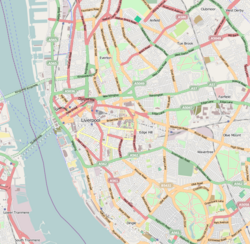Greenbank Drive Synagogue, officially the Liverpool New Hebrew Congregation, is a former Orthodox Jewish congregation and synagogue that was located on Greenbank Drive, in the Sefton Park area of Liverpool, England, in the United Kingdom. The congregation, formed through a merger of two congregations that date from 1838, worshiped in the Ashkenazi rite.
| Greenbank Drive Synagogue | |
|---|---|
 Exterior of the former synagogue in 2019 | |
| Religion | |
| Affiliation | Orthodox Judaism (former) |
| Rite | Nusach Ashkenaz |
| Ecclesiastical or organisational status | Synagogue (1936–2008) |
| Status | Closed (2008) |
| Location | |
| Location | Greenbank Drive, Sefton Park, Liverpool, England L17 1AN |
| Country | United Kingdom |
Location of the former synagogue in Liverpool | |
| Geographic coordinates | 53°23′22″N 2°55′45″W / 53.389310083°N 2.9292138662°W |
| Architecture | |
| Type | Synagogue architecture |
| Style | Art Deco |
| Date established | 1936 (merged congregation)
|
| Completed | 1937 |
Listed Building – Grade II* | |
| Official name | Greenbank Drive Synagogue |
| Type | Listed building |
| Designated | 11 May 1983 |
| Reference no. | 1298791 |
| [1][2] | |
The former synagogue building was completed in 1937 and was listed as a Grade II* building in 1983.[2] The building has been described as the most important 20th-century synagogue in England in terms of architecture, as well as the finest surviving architectural example of a synagogue from the interwar period.[citation needed]
History edit
Pretext for the foundation of the synagogue can be traced back to a split within the Liverpool Hebrew Congregation in 1838. From this, the separate New Hebrew Congregation established its own synagogue, first on Hanover Street, then on Pilgrim Street, before finally constructing a purpose-built synagogue on Hope Place in 1857.
After World War I, the number of Jewish congregants living close to the synagogue began to decline as they moved outwards to live in Liverpool's wealthier suburbs. One such area was around Sefton Park, where Hebrew schools and a substantial Jewish congregation started to take shape. By 1928, the Hope Place Congregation made plans to relocate and build a larger synagogue to accommodate the growing community in Sefton Park. On 15 August 1937, the new synagogue, which had been built in the Art Deco style, was consecrated and opened to the public by Professor Henry Cohen, 1st Baron Cohen of Birkenhead, a member of the congregation.[2]
In May 1959, a fire was started by a burglar which destroyed the Torah ark and its scrolls and damaged part of the roof's structure. At a cost of £50,000, the building was repaired and later re-consecrated in 1961. Another fire broke out in 1965, this time on the first two floors, but the damage was confined to the area.[3]
On 5 January 2008, the building ceased activity and was closed. Around the same time, Historic England upgraded the building's listed status from Grade II (awarded in 1983) to the higher Grade II*. It was subsequently placed on Historic England's "Heritage at Risk" register.[4] In 2017, approval was given for the former synagogue to be renovated into a series of apartments.[5]
See also edit
References edit
- ^ "The former Liverpool New Hebrew Congregation Greenbank Drive Synagogue". Jewish Communities and Records - UK. JewishGen and the Jewish Genealogical Society of Great Britain. 14 November 2023. Retrieved 3 May 2024.
- ^ a b c Historic England. "Greenbank Drive Synagogue (1298791)". National Heritage List for England. Retrieved 3 May 2024.
- ^ Bennett, John (19 May 2019). "Abandoned Liverpool: the empty buildings of our city, what's inside and what they once were". Liverpool Echo. Retrieved 25 June 2020.
- ^ "Greenbank Drive Synagogue, Greenbank Drive, Sefton Park - Liverpool". Historic England: Heritage at risk. Retrieved 25 June 2020.
- ^ "Synagogue conversion set for summer start". Place North West. 10 July 2019. Retrieved 25 June 2020.
